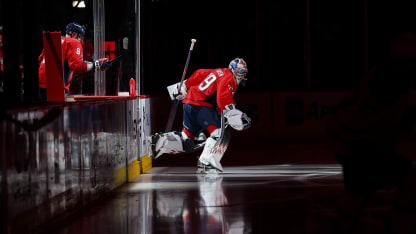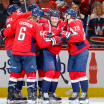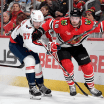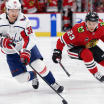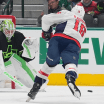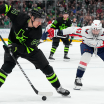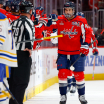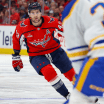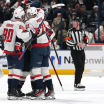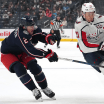Landing the final available Eastern Conference playoff berth in 2023-24 was a proud achievement for the Washington Capitals. They put on a late season surge to put themselves in a position of playing meaningful hockey throughout the final quarter of the campaign, unlike the previous season. But a two-week stretch of the summer of 2024 also indicated that the Caps aren’t resting on the low bar laurels of last season.
Washington’s hockey operations department undertook a significant makeover of the team’s roster over the summer, bringing in four forwards, two defensemen and a goaltender in what constitutes the team’s busiest offseason – in terms of player personnel additions – since the summer of 2005, when Alex Ovechkin was preparing to enter the NHL as a rookie and when all 30 clubs were feverishly remaking their rosters. The season-long lockout that killed the 2004-05 season finally ended in late July of 2005, making for a very short and suddenly busy summer for all GMs.
Six of this season’s newcomers are likely to make their debut with the Caps in Saturday’s season opener against the New Jersey Devils. If that turns out to be the case, Saturday’s game will mark an ultra-rare event in franchise history. Saturday’s game is the 3,880th in Washington’s regular season franchise history, and it would be just the fourth game in which as many as six players donned the Capitals sweater for the first time.
The first such event was quite obviously the first game in franchise history, on Oct. 9, 1974 at Madison Square Garden in New York. All 18 of the players in that game were suiting up for the first time. The second time was opening night of the 1982-83 season, on Oct. 6, 1982, also at MSG in New York. That game came less than a month after newly appointed GM David Poile swung the deal that kept the Capitals in DC, bringing Brian Engblom, Doug Jarvis, Rod Langway and Craig Laughlin to Washington.
And the third was Oct. 5, 2005, the night of Alex Ovechkin’s own debut in a Capitals’ sweater. When he steps on the ice for Saturday’s season opener, Ovechkin – skating in the 20th opening night game of his NHL career – will also become the only player in franchise history to appear in two of these four era-defining games.
“That does sort of tie it together with the 50th [anniversary season] and all of the changes that we’ve had over the last couple of years,” says Caps’ coach Spencer Carbery. “And this has been an ongoing process of trying to get younger, with some guys reaching the end of their careers. I think it’s a good bridge of what’s gone on in the past—and there is still great reflection – but also a look to the future and what the next 50 years looks like, and 10 years, and five years.”
The hockey operations remake took less than two weeks, and it affected every part of the roster. Once the deals were made and the contracts were signed, the Caps’ coaching braintrust began brainstorming line combinations and defense pairs. Those combinations and pairs were tentatively put forth in the team’s first training camp practice paces on Sept. 19. And with the exception of the late addition of defenseman Rasmus Sandin – who missed the early days of camp because of visa issues – those combos and pairs have held and may even closely resemble the team’s opening night lines and pairings, a rather unusual training camp occurrence, particularly in light of the sheer number of newcomers.
“I do think it’s cool to have that many new faces and then as they come in – and like I’ve talked about multiple times – they’ve fit in seamlessly,” says Carbery. “And hopefully that translates to our game when the regular season kicks off on Saturday. But as far as integrating with the group, practices, meetings, and seeing them feel comfortable, it has far exceeded what I thought it would be, having that many new players in.”
Of course, when this many new players arrive at the outset of a season, it often means some longtime stalwarts and fan favorites have departed, or in Washington’s case, are ailing. Legendary Caps Nicklas Backstrom and T.J. Oshie were both on last season’s opening night roster, but both are sadly absent this time around. Backstrom is on long-term injured reserve with a hip injury, and Oshie’s back ailment has him regular IR, as of now.
“You can never replace Backy and guys like Osh, guys that are such quality, character people,” says Caps’ right wing Tom Wilson. “But what you can do is learn from them, and you can take some of their qualities and morals and bring them to the room and try to be a better teammate. And those guys definitely made everyone around them better. I think they’ll have a lasting impression for years to come, and it’s our duty to keep that culture and keep that environment what it has been for the last decade plus.”
Offseason deals that reshaped the Washington roster cost the team goaltender Darcy Kuemper, defenseman Nick Jensen, and left wing Beck Malenstyn. After a solid first season with the Caps in 2022-23, Kuemper lost his hold on the No. 1 netminding job last season; Charlie Lindgren took over and led all NHL goaltenders in games played in the season’s final two months. Kuemper was sent to Los Angeles in exchange for 26-year-old center Pierre-Luc Dubois.
After the Caps signed right-handed blueliner Matt Roy to a seven-year contract on July 1, they were left with an excess of right-handers among their rearguards. Jensen played more games (372) in a Caps’ sweater than any other player from the date of his arrival (Feb. 22, 2019) until his departure over the summer; he was dealt to Ottawa on July 1 along with a third-round pick in 2026 for left-handed blueliner Jakob Chychrun, rebalancing the blueline after the Roy signing.
Malenstyn had an excellent first full season with the Caps as a physical fourth-line winger who also killed penalties. Washington drafted Malenstyn in the fifth round of the 2015 NHL Draft, and when Buffalo offered an early second-rounder nine years later at the 2024 Draft in Vegas, the Caps made the deal and used the pick to take Boston University blueliner Cole Hutson.
Minutes after the Malenstyn deal, the Caps dealt a pair of third-rounders to Vegas for goaltender Logan Thompson, who becomes Lindgren’s netminding partner this season.
Two nights before the Malenstyn and Thompson trades, Washington sent a second-round pick to Calgary for winger Andrew Mangiapane.
And finally, also on July 1, the Caps signed free agent forwards Brandon Duhaime and Taylor Raddysh to flank veteran Nic Dowd – the team’s lone right-handed center – on a line.
That’s a top-six center, a top-six winger, two bottom-six wingers, two top-four defensemen, and a goaltender, all coming into the fold this summer. Dubois, Roy and Duhaime are signed for multiple seasons; Mangiapane, Chychrun and Thompson are heading into the final seasons of their existing pacts. Raddysh signed a one-year deal.
“I’m always saying it’s a business,” says Ovechkin. “Of course, you have good friends, but it’s a business. Of course, you want to have a solid team and make the playoffs, and try to win the Stanley Cup. The last two years, we improved ourselves, but it was not enough. I think everybody understands that we need experienced guys who want to be part of that, and I think [management] did a pretty good job.”
Over the last decade, the Caps have consciously concentrated on building a strong culture in their room. And the organization has gradually become a more desirable destination geographically, since the team moved to downtown DC in late 1998. Washington has been able to establish a track record of bringing players to the District from other organizations, showing them the culture and the surrounding area, and getting them to sign contract extensions to remain here.
Oshie, Jensen, Dowd, Lars Eller, Brett Connolly, Michal Kempny and others have followed that path in the last decade. The Caps are now banking on that strong culture to help forge early bonds with new teammates, and to help them ease their way into their new environment as quickly and as smoothly as possible.
So far, so good.
“I can’t speak for the six others, but for me and from the vibe in here, it feels like it’s going really well,” says Dubois. “It feels like we’ve been here already for a long time. Just walking around – whether it’s on the ice or off the ice, or in the gym, or even away from the rink – I feel like I’ve been here for a long time already, and that’s what you want before the season starts. Because once the season starts, it gets really busy and there’s not as much time to hang out anymore.”
Dubois has been centering a line with Connor McMichael on his left, and Tom Wilson – a full-time alternate captain this season. That trio offers an intriguing mix of size, speed and skill – plus the drive of Dubois aiming to prove himself in a new organization, the hunger of young home-drafted and developed McMichael seeking to take a big step forward with his career, and the unique blend of two-way hockey, intangibles and leadership Wilson brings to the rink.
“Since I got drafted, this is the moment you've been working for, to prove you belong in the top six,” says McMichael. “To play in all situations – power play, penalty kill – to try and help the team win in every single way, over the past five or six years, this is what I've been working for. And I think playing with Willy and Dubes, it's made it really easy for me. They are two guys that have an easy time getting pucks back and making plays, so I think we gel well together, and I'm really excited.”
Mangiapane has been slotted in on the right side of a line with Ovechkin and Strome, the team’s two top scorers from last season. He’s averaged 21 goals for every 82 games played over a seven-year NHL career, and he had a career best 35-goal, 55-point season in 2021-22.
The 28-year-old Toronto native is adjusting well on the ice and in the room, but he is still feeling his way around the area.
“It’s just all kind of new,” says Mangiapane. “I played in [AHL] Stockton before, so I know a little bit of the U.S. But it’s just being an adult again – finding a place, getting renters’ insurance, finding furniture. It’s just all that outside of hockey stuff.
“When you come to the rink, it’s the same. It’s a great group of guys and a lot of fun to be here. I love being on the ice and love this atmosphere. In that way, it was always going to be an easy transition for me. And away from the rink, you’ve got to be an adult for a little bit and do all those adult things. That’s been more of a struggle for me than it is here at the rink.”
On the ice, Mangiapane is a tenacious forechecker who has been a strong possession player throughout his career. And he knows what to do with the puck in that area of the ice.
“It’s just about building chemistry and knowing what [Ovechkin] and Stromer like from me and what I want from them as well,” says Mangiapane. “It’s been a lot of fun playing with them; those two are both great players. And for me to best compliment them is just playing my game. I’m a hard on the puck type of guy, be first on the forecheck, try to turn the puck over, set up those little plays where O and Stromer can use their quick pass, quick shot abilities. I think that’s what makes us an intriguing line, we can complement each other well.”
Like that play that Mangiapane made in the Caps’ Sept. 27 preseason game against Columbus, picking a pocket on the forecheck and feeding Ovechkin for the finish on the swipe and snipe?
“Yeah, that’s my game,” he nods. “Getting in there, disrupting, keeping pucks low. Maybe low-to-high, getting pucks back, and just keep doing it over and over. The more chances I can create for my linemates, the better. They’ll be able to score more with more opportunities.”
As he heads into his seventh season in Washington, Dowd has a pair of new linemates in Duhaime and Raddysh. Since he entered the NHL in 2021-22, Duhaime ranks sixth in hits/60 (14.90) among all skaters with 200 or more games played over that span. He is used to the heavy defensive-zone deployment his line is likely to see; he was utilized in similar fashion in Minnesota. Raddysh is a right wing who had 20 goals for Chicago – seven of them on the power play – two seasons ago. He is a guy who is capable of playing either wing, and he can move up in the depth chart, if needed.
Dowd played his 500th career NHL game in the regular season finale last April, and as the longest tenured Capital beyond the remaining core from the 2018 Stanley Cup team, he has become more of a voice and a leader. His communication with his linemates – regardless of who they’ve been through the years – is well known, and it has been a boost this fall with so many new faces.
“He looks really good physically,” says Carbery of Dowd. “And his training camp – last year he was coming off of injury, and he wasn’t skating right at the beginning of training camp; he was in a red jersey and was in and out, and he didn’t play in the first few preseason games. But he looks really, really good physically.
“And I notice him a lot more from a leadership [standpoint], helping the young/new guys. He’s vocal, [he brings] great energy, setting the example from practice habits, going first in drills – all the stuff that you would want to see from one of your leaders. He’s really stepped up his game in that department.”
The Caps lean decidedly left up front, and their remaining four forwards are all southpaw shooters. Jakub Vrana – the third-leading goal scorer from the 2017-18 Cup championship team came to camp on a PTO deal and earned a contract in one of the feel-good stories of camp, but he will have to battle Sonny Milano for playing time at season’s outset.
Hendrix Lapierre centers for Milano and Aliaksei Protas, and like McMichael, Lapierre and Protas are both young, Caps-drafted and developed players seeking to make an upward climb in their careers this season.
“I think it’s just learning every day, and my mentality is that every day I’m going to do what I can to have success,” says Lapierre, the MVP of the 2024 Calder Cup playoffs. “And eventually, when those days add up and you do a little bit of extra and stuff like that, eventually you gain positive things from that. For me, it’s about sticking to the process. I know that’s very cliché, but that’s really what it was; one day, you’re going to feel comfortable, you’re going to feel better. You’ve just got to get used to it.
“I don’t think there was a point last year where I felt like I really flipped a switch. I started the year strong in the [AHL], then I had a little bit of a taste in the NHL. I got back to the [AHL], and when I finally got back in February, it was like, ‘Okay, now it’s time to shine.’ And the worst thing that can happen is I get sent down again, right? And I’ve been sent down three times. So I was like, ‘All right, let’s just do it.’ And I started playing really good, and I was feeling comfortable and getting a sense of all of this. And now I feel like I belong here, I want to play here, I want to have an impact, and I want to help the team win.”
Over the final 33 games of last season, as the Caps were making their push toward the playoffs, Ovechkin overcame a slow start to score 20 times, leading that late charge. Milano – despite missing seven of those last 33 games – and McMichael were tied for second with 11 goals each during that stretch.
Lapierre and Milano each had 15 points during that stretch – tied for 6th on the club – despite ranking 11th and 12th, respectively, in average ice time per game during that span. Protas’ season was stronger early when the Caps were particularly challenged offensively. Through the first 34 games of the season, Protas put up 18 points (three goals, 15 assists), tied for third on the team over that span, and only three points behind co-leaders Ovechkin and Strome.
Those 13 forwards have the potential and the upside to deliver more offense through all four lines for Washington this season, and the revamped defense should also help in that regard.
John Carlson enters his 16th NHL season as the Caps’ all-time leader in virtually every category. At age 34 last season, he established a single-season career high – and NHL-leading – average ice time of 25:54. With the additions of Chychrun – Carlson’s new partner to start the season – and Roy, the Caps should be able to pull back on Carlson’s workload this season.
Chychrun has averaged upwards of 20 minutes each of the last seven seasons, since he was 19. And he has plenty of offensive wherewithal, along with a bomb of a left-handed point shot. He played all 82 games last season for the first time in his eight-year NHL career, and Chychrun averages 13 goals and 38 points per 82 games as he heads into the prime seasons of his career.
“I think it would be great,” says Chychrun of the prospect of playing with Carlson. “I’m really excited for it. I feel like I enjoy playing with guys who think the game the same way. John and I are both guys that love to generate offense, and take pride in defending and playing in all situations on the ice and all situations of the game. I think we’ll really be able to play off one another, make reads off one another, and I’m excited to see where it goes.”
Roy has been skating the right side of a pairing with Martin Fehervary, a duo that has the elements you’d seek in a sturdy shutdown pair. But both are excellent skaters, and both have displayed some lamp-lighting ability in the NHL; Roy scored nine goals – all at even strength – two seasons ago and Fehervary netted eight – one shorthanded – as a rookie in 2021-22.
“It’s been good,” says Roy of training camp with his new partner. “We may still be getting to know each other a little bit, but I think our games are going to suit each other well. I think we’re both hungry to go get the puck and we’re not afraid to go in and get the puck, and I think we’re both defensively minded first. And we’re not afraid to join the rush, so I’m excited to play with him.”
Adding two top-four defensemen in the same offseason is also no small feat in the NHL. When the Caps have been able to do it previously – with Rod Langway and Brian Engblom in 1982 and with Brooks Orpik and Matt Niskanen in 2014 – good things have followed.
“We were talking about the mix of skill sets and depth, and I think it gives you two really good guys at both of those aspects,” says Caps general manager and vice president Chris Patrick. “Matt Roy gives you a guy that's first and foremost a really good defender, but he can also get up the ice a little bit and shows some willingness to do that. But he'll be able to play against good players and take some hard minutes. And with Chychrun, I think you have a guy that's got a lot of offensive talent, and a big, strong guy that can handle guys in his own end as well. But he is certainly a guy that gives you another offensive element on the blue line.
“Hopefully, what we've done is we've added two guys in each category that are at the higher end of that category for us.”
The additions of Chychrun and Roy also make the Caps deeper in back. Rasmus Sandin and Trevor van Riemsdyk combine to give the Caps a seasoned third pairing. Sandin is seen as more offensive type who can play on the power play and van Riemsdyk is a 600-game veteran capable of playing on either side. Both have shown the ability to play more minutes – and in multiple situations – should the need arise
Washington is carrying eight defensemen, with the ever-improving Alex Alexeyev and three-time Calder Cup champ Dylan McIlrath as a fourth lefty/righty pairing. Both players brim with quiet determination and have worked tirelessly to improve their respective games over the last couple of seasons.
The Capitals’ revamped blueline brigade is constructed – and expected – to spend less time in its own end, and more time fueling the team’s attack. The Caps were 26th in the NHL in basic possession metrics at 5-on-5 last season, but if this group meshes well and is reasonably healthy, it could climb to the top 10 – or certainly to the top half – of the League in ’24-25.
In goal, the Caps have Lindgren, winner of 38 games in his first two seasons in DC, including a career-high 25 last season. Lindgren and Thompson will share the net this season, the first time the Caps have ever had a right-handed catching tandem in their 50-year history.
Both goaltenders are in the final season of their contracts, both were overlooked in the draft, and both have proven their NHL mettle. This season, Lindgren and Thompson combine to give the Caps the goaltending tandem with the lowest combined salary cap hit ($1,866,667) in the NHL. Both also have plenty of career runway ahead of them, and plenty to play for this season.
“I'm hopeful and fully expecting that it won't be the cheapest goaltending tandem a year from now,” says Patrick. “We have one goalie under contract [Clay Stevenson] after this season. So, I think it's a great opportunity for three guys [including Hunter Shepard] to come in and show us what they have. And hopefully we'll be able to figure out the direction we want to take in our goaltending department, based on how they play.
“To me, it's an open competition, rewarding players for how they perform, and trying to put the best group on the ice. We'll see how it plays out, but I think it's a good spot to have three guys competing for that position.”
Lindgren has been routinely effusive in his praise for the players – and particularly the defense corps – in front of him in two seasons here, and they seem to love playing in front of him as well.
“As we get going here with the season, we’ll become more comfortable and familiar with each other,” says Lindgren of his many new teammates. “I have a lot of faith in our back end, and the guys we brought in are real high-end guys, and they’ve got experience in this League. I’ve got zero issues and zero worries about what’s going on in our back end, and zero issues with what’s going on up front, too.
“Top to bottom, I really like what we have going on paper. As I’ve mentioned many times, paper really means nothing because talent doesn’t win hockey games; a lot of it comes down to work ethic and the way you play. But it’s a really good group on the ice and off the ice.”
Lindgren’s point is valid. The offseason moves look great on paper, and they address legitimate concerns and holes on the roster. But the Caps are one of 32 teams in an ever-evolving NHL ecosystem. Now, with 82 games stretched out in front of us, we get to see how it all plays out, chapter by chapter. And every year at this time, and for the next six – ideally, nine – months, that’s the fun part.
“If you look at our history of this franchise, they're not satisfied just making the playoffs,” says McMichael. “We want to make a run and go deep. And I think management really set us up for success this year. They've gotten a lot of speed, and a lot of new guys that can contribute. And I think every single one of those guys has shown in preseason what they can do and how they can make a difference for this team.
“I think we're going to be a lot better than last year. Not to get ahead of ourselves, but if we, if we play how [Carbery] wants us to play, the results are going to come. I think we're going to have a lot more fun than last year, especially at the start of the year, I think having a lot of youth and speed, and guys that are motivated to prove why they traded for them, why they signed them, whatever it may be, I think that's going to be an important factor for our group.”
The 2024-25 Capitals are an interesting mix of players and characters offering intriguing upside and potential, given their large influx of new players entering or in their prime seasons, a group of upcoming home-developed and drafted players, and the remaining core from the team’s 2018 Cup squad.
“From what it sounds like, it's given a little jolt of energy to the group,” says Patrick of the offseason remake. “It feels like there's a lot of positivity in the locker room right now. I think that comes from some new people coming in and wanting to prove that they belong, that they can help the team, that they've earned the contract they got, or that someone was wrong about them along the way.
“And I think it comes from the existing guys. You have some new faces, and that is kind of exciting. And the prospects of playing with this guy might be fun, or it's going to be fun to see what this guy can do on a nightly basis. Just in general, I think the group's been a little energized by it, so it should be fun.”
Every year at this time and in almost every NHL city, there is excitement and energy surrounding the start of another new season. But this season in this city, that energy is more palpable than usual.
Two years ago at this time, the Caps were an obviously aging group. Seventeen of the 26 players on the team’s opening night roster were 30 or older; a few were injured and in the midst of rehabbing at the time, but all returned and played that season, hence the number of players being higher than the roster limit. That club didn’t make the playoffs – the team’s first miss since 2013-14 – and the gradual makeover actually began at the trade deadline in Feb. 2023. Only seven players of the 23 players on this season’s opening night roster are 30 or older.
“When you see your team making moves to improve what we built on last year, as a player it gets you excited,” says Wilson, who somehow is now one of those 30-plus players. “It gives you a shot of energy to get hungry, get competitive. I think we found out a lot about ourselves last year as a group, and there is a culture here that we’ve built over the years.
“And then this offseason, to go and find guys that add to all of that, and all of the guys are phenomenal additions. They’re great people, and obviously really good hockey players. It’s rare to go out and bring in so many new faces, and right across the board every guy is such a good guy and can obviously bring it on the ice, too.
“I’m excited about this group and this year.”

